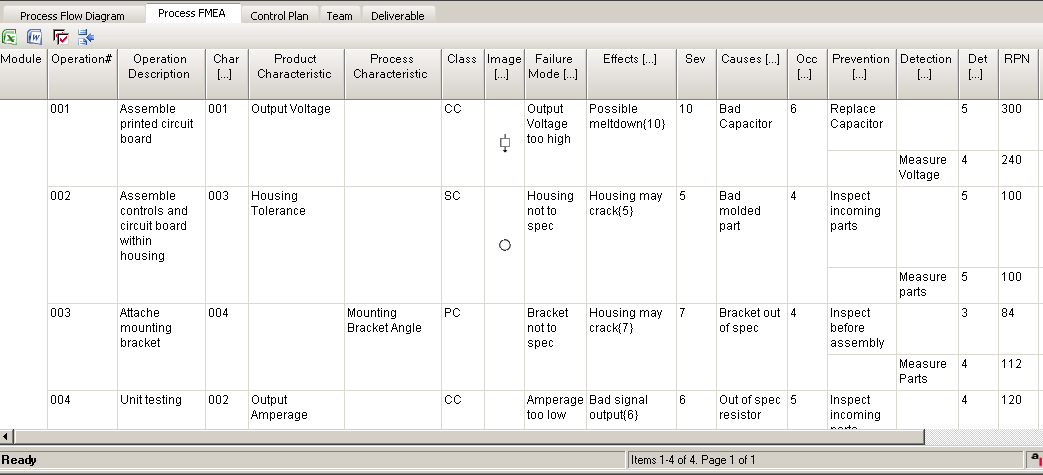-
Process FMEA
The Process FMEA is the second tab of the Process Planner, and it is very similar to the DFMEA.

The Operation #, Description, & Characteristic are common properties among all of the tabs of the Process Planner.
Let's take a look at the other properties:
1. - the class of the characteristic. If a characteristic is entered in this row's cell, its classification will automatically appear here. However, you can also override the classification by editing and selecting a value from the drop down list. These options come from a configurable list where each company may enter their own classifications. Usually, the following would be available:
a. - Critical Characteristic
b. - Fit/Function
c. - Significant Characteristic
- Safety/Compliance
An optional image that can be selected to represent the characteristic. The image is automatically displayed on some of the standard Innovator Quality Planning reports. This field is set through the Characteristic Browser.
3. - the manner in which the item could fail; you can either type in an entry, or hit F2 to bring up a Failure Mode Catalog. You can start multiple nested rows at this point to indicate that for a specific function there are several failure modes that carry with them
4. - the effects of a specific failure mode. The Effects sub-dialog is automatically displayed when the cell gains focus. Select one or more effects to be displayed as a comma separated list in the grid cell.
5. - Severity is a rank associated with the most serious effect in the list. It is populated automatically, when the effects are selected.
6. - potential causes or mechanisms of failure. For each , there can be more than one cause. You can either type in a value, or hit F2 to select from a Causes Catalog. Each cause entered will start a nested row.
7. - the likelihood of failure occurrence on a scale of 1 to 10. Once the cell gains focus, the Occurrence Catalog will display from which a selection can be made.
8. - part of the control; possible methods of preventing this failure from happening. A Controls Catalog displays to allow the user to select a prevention method.
9. - part of control; describes measurement techniques to be utilized to detect possible failures. A Measurement Technique Catalog can be used to select standard measurement methods appropriate to the situation
10. - the likelihood that the control method will catch the failure; select from the options presented in the popup dialog.
11. - Risk priority number; automatically calculated based on previous entries. If the number is high enough (exceeds a company specified threshold), then actions need to be taken to lower it.
12. - the actions that will take place to lower the RPN. The Reaction Plan Catalog contains a list of possible actions for the user to select. Once the appropriate data is filled out, the action is sent to the responsible personnel. That person then fills out the Task Completion Worksheet.
13. - the general department or group that will be responsible for the Actions. The options are Manufacturing, Design, or Evaluation.
14. - the specific personnel responsible for the Actions. When this field has a value of a particular identity, the actions will be sent to that person's In Basket to start the implementation process.
15. - a target date by which the specified actions should be completed.
At this point, this row of the PFMEA is complete. When saved, the action item is sent to the of the identity specified in the column. When they complete the action items, they fill out the Task Completion Worksheet with the required data. This data is then available from the PFMEA as well. The fields below duplicate the information from the worksheet.
16. - the actual date when the actions are completed. This is filled out by the responsible personnel upon completion, in the Task Completion Worksheet.
17. - the action taken by the responsible personnel. Echoed here from the Task Completion Worksheet.
18. - the new severity, after the actions have been taken. The value is automatically copied from the Task Completion Worksheet.
19. - the likelihood of failure occurrence on a scale of 1 to 10. Typically, after the actions are taken, the Occ should be decreased. The value is copied here automatically from the Task Completion Worksheet.
20. - the likelihood that the control method will catch the failure, again after the actions are taken. The value is from the Task Completion Worksheet.
21. - the new value of the risk priority number, should be reduced below the company set threshold.